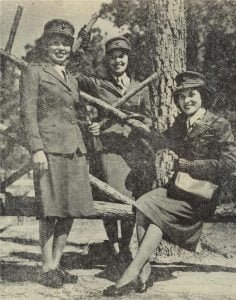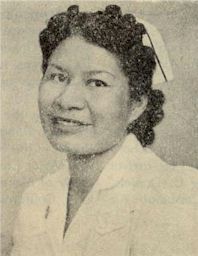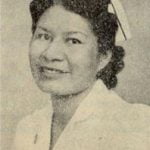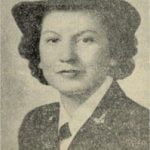
Left to right: Minnie Spotted Wolf, Blackfoot, Montana; Celia Mix, Potawatomi, Michigan; Viola Eastman, Chippewa-Sioux, Minesota
Indian women, anxious to help out during the war-created manpower shortage, have made an astonishingly large contribution to their country’s needs. Thousands of them have left their homes to work in factories, on ranches and farms, and even as section hands to replace men who were vitally needed elsewhere. They have joined the nurses’ corps, the military auxiliaries, the Red Cross, and the American Women’s Voluntary Service.
Not content with this, they have given their services in many other and more unusual ways. More than 500 Eskimo and Indian women and girls worked day and night manufacturing skin clothing, mittens, mukluks, moccasins, snowshoes, and other articles of wearing apparel for our forces serving in cold weather or at high altitudes. An Alaskan Indian woman ran a trap line to make money for war bonds.
Cherokee girls wove and sold baskets, buying war stamps with the money. On the Eastern Cherokee reservation, women and girls planted and harvested the crops, and even drove tractors.
Forty Chippewa women formed a rifle brigade for home defense. An old Kiowa woman gave $1000 to the Navy Relief Fund as her contribution. Osage women, draped in their brilliant blankets, spent long hours at sewing machines for the Red Cross.
In the West, a Pueblo woman drove a truck between Albuquerque and Santa Fe, New Mexico, delivering milk to the Indian school. She not only serviced her own truck but also helped at the school garage as a mechanic. Many Indian women became silversmiths, and made Insignia for the armed forces. At Fort Wingate, New Mexico, the Navajo women’s work ranged from that of chemists to truck drivers. Two Indian women in California served at a lonely observation post, driving the twelve miles to their position in a rickety old automobile.
The war plants had many Indian women on their rolls, working as riveters, Inspectors, sheet metal workers, and machinists. An Indian girl was chosen at one plant to receive the Army-Navy E for her fellow workers.
In the Indian forests, hitherto considered as providing work fit only for men, the Indian women learned to take over many tasks. Treatment for blister rust was given 80,182 acres of forest, mainly in the Lake states, and Indian women performed much of the labor. On the Menominee reservation in Wisconsin, fifty women replaced men at the mill. Crews consisting of two women and one man planted young trees to replace those cut down in the Red Lake forest in Minnesota. During the short period in the spring, which is considered most advantageous for such planting, 90,700 trees were replaced on 238 acres of land. Indian women have “manned” fire lookout stations on the Colville and Klamath reservations. An Indian woman acted as guard at the Dry Creek station on the Yakima forest, and another learned to be a radio operator at the central camp on the Quinoas reservation.





